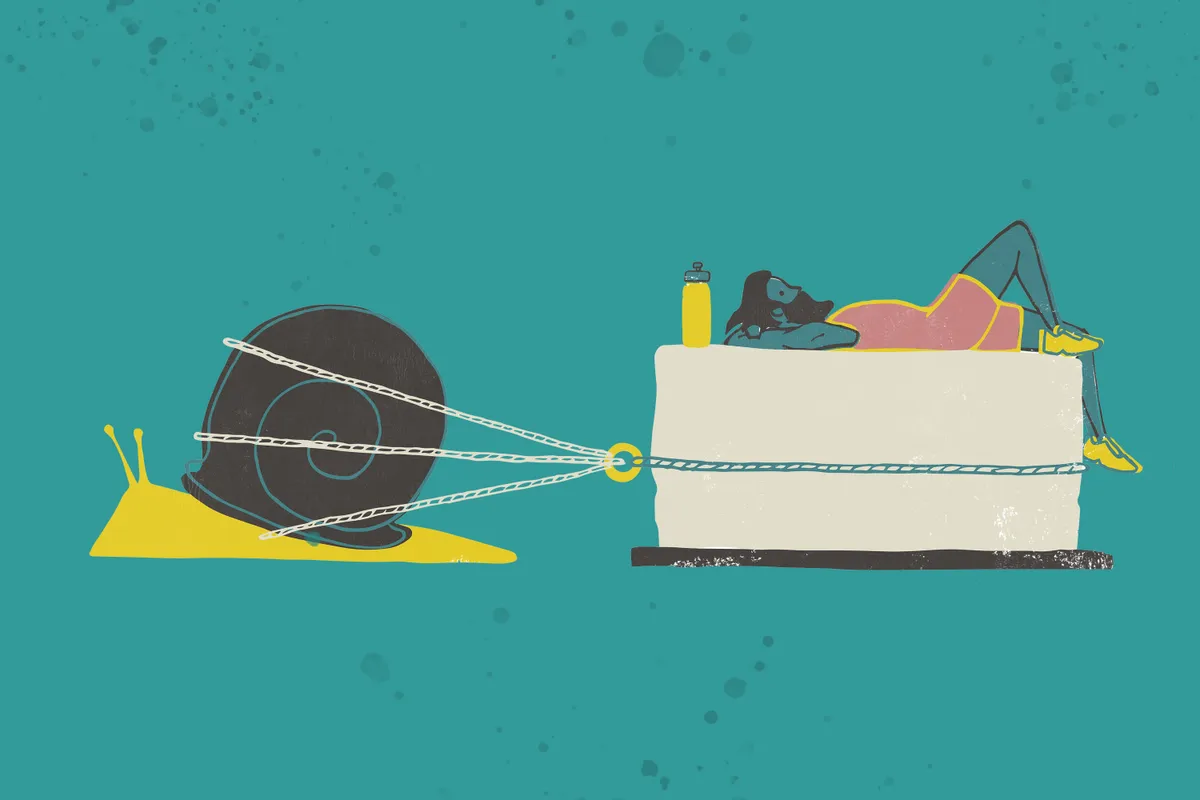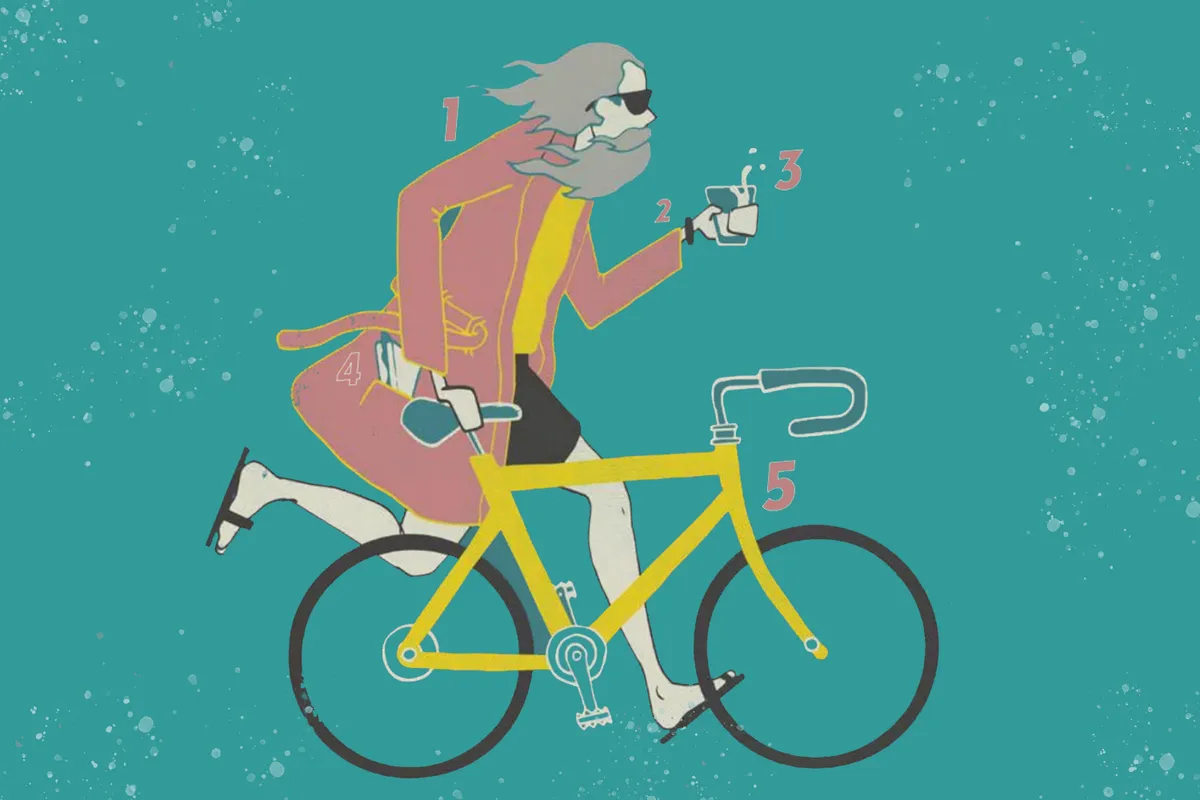Slacker and triathlete. Two nouns you rarely hear connected. One suggests a lifestyle largely conducted horizontally. The other is seen to only get horizontal when swimming or power napping between high-intensity sessions, the ultimate sporting figure with broad shoulders, calves of steel and abs made from titanium.
There’s a reason why the BBC wheels out triathlon for every Children in Need challenge, right? And yet, these unlikely bedfellows don’t have to exist in mutually exclusive realms. I, for one, classify myself as both slacker and triathlete, and I know plenty of other triathletes whose primary goals when ‘racing’ include getting to the burger tent – sorry, finishing line – before it’s dismantled.
Completing over competing has largely been the mantra of my triathlon career, and yet it’s one that’s taken me from sprint-distance races at Dorney Lake to the Snowdonian mountain climbs of the Slateman and off-road adventures in the Cairngorms via the world of Ironman-distance events. And all on a handful of hours of training per week.
I still play Lego with my kids and spend evenings with my longterm loves – the sofa, a bag of lime Doritos and my Nicolas Cage DVDs. Charles Darwin reportedly only worked three hours per day, and it’s a productive approach you can take with triathlon.
Maximise the hours you have, establishing clear goals and enjoying every minute. Here’s what I’ve learnt – and what you can too – from my 15 years of triathlons, while remaining a Big Lebowski fan…
Train slow

“The dictionary defines slackers as people who evade responsibilities. A more modern notion would be people who are ultimately being responsible to themselves and not wasting their time.” The words of Richard Linklater, the godfather of slackerdom and director of such classics as Dazed and Confused and Slacker.
The point is to maximise the hours you have to train. Enter the lunch break and the commute. Tired of Wilko Wednesdays? Then set aside four lunchtimes a week to train (with one day reserved for curry club), utilising the 30-45mins for speedwork sessions or recovery runs.
It’s also an ideal time to get in a swim, especially if you regularly work from home (the ultimate goal of any slacker) and live near a pool. Also think about extending your commute on the bike or run, or running to pick up the kids (a true school run).
And unlock the door to the ultimate triathlon session: the brick. For multisport, this can be any of the disciplines put together in training. “These sessions can be done outdoors around a measured run and bike circuit; using a run route then biking on a turbo at home; or even at a gym, jumping between a treadmill and stationary bike,” says multiple duathlon world champ Cat Morrison.
It can just be a 5min run after a 30min ride. The point is to get your body used to the fatigue and multi-faceted demands of racing, especially countering the ‘jelly legs’ syndrome of trying to run post-bike. Remember, even if you’re time-short, every session doesn’t need to be frenetic and high intensity.
The tendency is to go hard for every workout (often leading to injury), but a rough gauge is to train hard for approximately 20% of your sessions, leaving the other 80% for lower intensity and recovery sets, which has been scientifically proven by Dr Stephen Seiler. Train slow to race fast? It’s a slacker dream.
Build pyramids
Repetition, chlorine and lane politics. The pool once crossed that line for me when exercise became a chore. That is, until I bought a waterproof MP3 player. Yes, the sound may be muffled, but losing yourself in Aphex Twin when semi-submerged under the water can be a pretty far-out experience.
A one-paced swimmer will only learn to swim one-paced, so mix up the tempo of your lengths as well as the distance. The next step is to bring in the pyramid sets (below) to build both endurance and speed.
Front crawl or a mix of this and breaststroke is ideal for these:
Warm-up: Swim 100m
Main set: Swim the following slightly faster than the warm-up
- 50m swim (10sec rest)
- 100m swim (10sec rest)
- 150m swim (10sec rest)
- 100m swim (10sec rest)
- 50m swim (10sec rest)
Cool-down: Swim 100m Go a little further each week (add in 200/250m reps) and think about your technique.
The greatest tri swimmers I’ve seen barely make a splash. The best advice I’ve received is to grip the water with your entire forearm and hand on the pull of your stroke, don’t breathe behind you, and keep your fingers slightly splayed like a paddle.
Without looking too much like a weirdo, also watch the fast lane swimmers above the surface and from underwater to see their technique in real life. And don’t let anyone tell you that breaststroke is wrong.
If you feel comfortable doing it to relax your breathing or heart rate, help with sighting in open water or just for efficiency, then do it. Completing the full swim distance without stopping – either in the pool or open water – ahead of the big day will give you a further boost.
- Waterproof headphones for swimming
- How to use the pool to prepare for open-water swimming
- How to make progress in every swim session
The bike
The advent of the ‘smart’ and quiet turbo trainer has heightened the slacker appeal (see our reviews of the best turbo trainers). It’s a chance to watch Arrested Development boxsets and do exercise.
Interval training is a great (and fast) way to build fitness. After a 5min warm-up of easy spinning, alternate 2mins of hard activity with 2mins easy for 20mins before a 5min warm-down. You can increase this number of sets each week.
An indoor cycling app like Zwift will also add a gamification element, while the convenience of having a turbo ready to go in the garage or bathroom will add motivation during the winter months. And yet, for all the ease of indoor cycling, getting outdoors is where you’ll gain bike handling skills, more enjoyment and a vitamin D hit.
If you’ve only room for one bike, make it gravel and explore the off-road network of trails. As well as the pure enjoyment factor, riding off-road will increase your bike- handling skills and build stamina swiftly due to the tougher under-wheel terrain.
Like breaststroke on the swim, don’t let anyone tell you it’s wrong to wear running shoes on the bike. If you don’t feel confident wearing clipped-in bike shoes, don’t bother.
You’ll lose some efficiency but save yourself time in the bike-to-run transition (T2) by being ready for the run. (If you do want to use clipless pedals, practise unclipping on grass or the turbo, and remember that SPD-style mountain bike shoes are easier to unclip from).
If transition is the fourth tri discipline, nutrition the fifth, then strength and conditioning (S&C) is definitely the sixth. My previous S&C regime consisted mainly of mashing potatoes. But squeezing in some strength, mobility or flexibility exercises (while you’re waiting for the Super Noodles to boil or watching the adverts during Bill and Ted on 5Star) are easy – and free – wins for every multisport athlete.
The run
No pool fees, no punctures, minimal kit and a chance to get lost in the woods with only the music of Dinosaur Jr for company. The simplicity and purity of running is something to be cherished.
Add fun into the mix with fartlek. Not a Scandi slacker band, but the Swedish word for ‘speed play’ and a form of interval training (where you fluctuate between high and low intensity) to boost running or cycling speed.
Warm-up for 5mins and then alternate periods of hard and easy – usually around 30secs to 4mins – or use geographical features as markers, such as a postbox or top of a hill. (Hill reps are also a hugely efficient way of boosting fitness gains).
Helping my dodgy post-football knees has been a move to trail running for that key long run, with the softer off-road surfaces reducing my injuries and improving my run technique.
That variation in surfaces also activates a greater number of muscles, ensuring your core receives a workout, too, as does the climbing and descending that trail running often brings.
Every slacker loves a Sunday, but before the Neil Young vinyl and roast potatoes come out, I ensure Sunday is my day for a long (90min-2hr) run (or ride) largely at a lower intensity.
Take a handful of sweets and hit the trails at dawn after a bowl of porridge, a perfect time for a podcast, playlist or just listening to nature. The early exertion will also make you enjoy that Yorkshire pudding even more…
The kit

From DIY tricks to aero cheats, here are five easy ways to get to that finish line on a budget...
- Cut yout hair - The most famous song by Pavement, the ultimate slacker band, is Cut Your Hair. And cutting down on hair is a surefire way to gain race speed on a budget. I shaved my legs and the result was a 21sec saving over a 40km bike leg. Lose the beard and you’ll go even faster…
- Stop swim sickness - The motion of open-water swimming can make you feel nauseous and lead to sickness in T1 (swim-to-bike transition). Don’t worry, we’ve all been there! Helping us now are a pair of £2.99 (anti-nausea) travel sickness bands from eBay.
- DIY drink - Using a sports drink delays fatigue and enhances performance. Make your own 500ml sports drink with a recipe from the English Institute of Sport’s Dr Kevin Currell: Add two tablespoons of sugar, a quarter teaspoon of salt, no-added-sugar cordial and top up with water.
- Real food - Peanut butter and jam sandwiches, flat cola, jelly babies… our transition area during the an event often looks like a buffet for a kids’ party. But mid-race treats with an energy boost are a great and cheap way to help you get through race day.
- DIY bike fit - Bike fits are ace, but they can cost £200. For a DIY option, set a saddle height where your knee barely locks out at maximum extension. To get the most force applied to the pedals, the knee should be above the pedal axle when the crank is in the 3pm position.
Tri tech
Tri can be as expensive or as cheap as you make it. Top-end kit will cut your hydro and aerodynamic drag, often while increasing comfort. And yet wisely-chosen budget kit should provide the comfort part of the equation.
Slackers might like loose clothing but that shouldn’t apply to the swim and bike. A decent fit will wick sweat away better, chafe less and won’t hinder you aerodynamically.
While it goes against the slacker ethos, go mainstream with budget tri kit: Decathlon offers some decent tri-suits and helmets for £30; dhb has some fine wetsuits for £100; and Aldi do passable eyewear for £2.99.
You can pick up some decent circa-£500 bikes from Halfords and Decathlon. So screw brand snobbery and buy what suits your tri needs and budget. Just make sure it fits you and you’re not buying it just because it’s on offer.
My £220 Carrera road bike from 2008 is still going strong today, with wheels, saddle and especially bike tyre upgrades worth saving up for.
“You wouldn’t fit budget rubber on a Ferrari, so don’t skimp on your bike tyres,” says BikeRadar’s senior tech editor Warren Rossiter.
I once prided myself on training ‘by feel’ and not using tech (largely because I couldn’t work the tech), but a relatively cheap Coros watch purchase was revelatory. It offered a range of long-term fitness tracking measures, allows me to compare session data and set daily targets (an even cheaper fitness band can also set calorie counts and more).
If that sounds too techy, keep a training diary and record every session, noting your times, how you felt and where you went.
And don’t neglect music. Plenty of studies have shown that it boosts concentration, provides ongoing stimulus and produces a positive influence. Just go for something up-tempo (LCD Soundsystem’s 45:33 is a wonderful track) over that Leonard Cohen album….
Nutrition

Maltodextrin solutions! 2:1 formulations! Creatine and glutamine! The sports nutrition market is big business. Some of it is very good, some dubious, and most of it is far more expensive than making your own.
One of the most proven (and frugal) ways of pre-exertion fuelling is caffeine, which boosts cognitive and physical function by a significant amount by stimulating the central nervous system.
I’ve previously made the mistake of replicating a manufacturer’s claim that triathletes should consume an energy gel every 15mins, costing me a fortune and some mid-run visits to the bushes. And this was on training runs.
The key is working out how much carbohydrate you need to ingest per hour when racing, and incrementally teaching your body to consume that in training at least five weeks ahead of the race.
Around 60g of carbs per hour is common (Precision Hydration has a useful carb calculator), and not all of these carbs need to come from just gels.
Jelly babies and beans, jam and peanut butter sandwiches on white bread, and Soreen bars are all affordable ways to receive carbs and energy during training and racing. The latter are the go-to option for cyclists for on-the-bike fuelling.
As for recovery, a decent stretch should follow any session (don’t neglect the post-bike warm-down) and then have a glass of milk with a spoon of Yazoo powder for your recovery needs instead of a pricey pre-made solution.
Having an ideal weight target and trying to reach it – and remaining there – by slightly reducing portion sizes and opting for 5% fat mince has also personally helped me reduce the beer belly that appeared in 1998.
As for the post-race pint, Guinness (less carbs than watery Budweiser) and Sierra Nevada pale ale (a higher content of polyphenols, an antioxidant that lowers cholesterol) are top of my list.
Tri racing
Goal setting, targets and accountability. It’s here we veer away from the classic slacker ethos. But planning out your season in advance is a great way to set goals and targets along the way.
Want to achieve your first 1km open-water swim? Mark a date on the calendar to complete it by, and tell someone to increase your chance of doing it.
To keep things interesting, I rarely do the same race twice. You can also mix it up with free parkruns, duathlons, off-road triathlons and single-discipline events leading to a mid/late summer ‘A-race’.
And if you’re clearly not fit enough come that A-race, don’t beat yourself up about posting a DNS (did not start). “There will always be another race,” says coach Will Newbery.
As for race day itself, ensure you’ve had plenty of open-water swimming experience before the event in your chosen wetsuit. Start at the back and to the side on the swim to avoid getting tangled with other swimmers, and find a landmark to head for so you don’t waste valuable yards swimming off course (switching to breaststroke can help).
Use both transitions to regroup, refuel and calm yourself, and keep feeding on the bike leg. Ultimately, whatever distance you’re aiming for, tick off up to 75% distance in each of the disciplines ahead of the race.
So for a sprint triathlon (750m swim/20km bike/5km run), we’re talking 563m swimming, 15km cycling and 3.75km running.
The excitement and free jelly babies should do the rest on race day. And, if you find yourself in need of a motivational quote, here’s one from Donald J. Trump. “The big time isn’t for slackers.” Now let’s prove the orange man wrong…
Top illustration: Daniel Seex for 220 Triathlon
